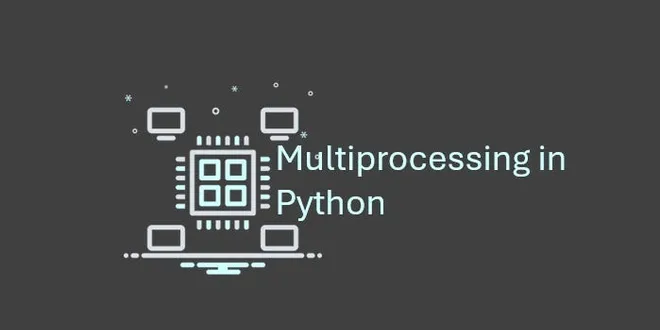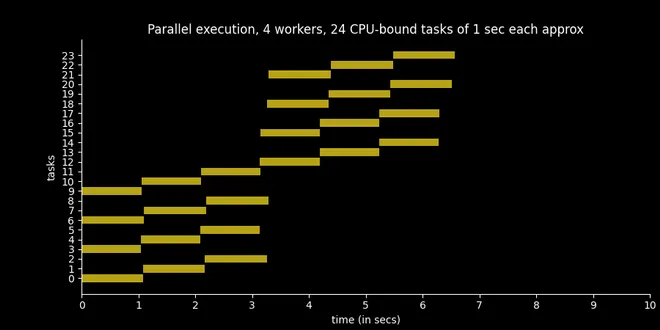Discover the best resources to learn about AI & Software Engineering - With AI⚡️Tutoring
Multiprocessing-in-Python
Multiprocessing in Python is a powerful technique that allows developers to execute multiple processes simultaneously, leveraging the full potential of multi-core processors. By utilizing the built-in multiprocessing module, Python enables the creation and management of separate processes, each with its own memory space. This is particularly beneficial for computation-intensive tasks, such as training machine learning models or processing large datasets. Unlike multithreading, where threads share memory and can lead to complications, multiprocessing ensures that each process operates independently, making it ideal for tasks that require complete isolation and parallel execution.

Python Multiprocessing with a Real-World Example
Multiprocessing in Python Python’s multiprocessing library enables developers to speed up applications by distributing work across cores. Multiprocessing lets a computer handle multiple tasks simultan...
📚 Read more at Python in Plain English🔎 Find similar documents

Python’s “multiprocessing” Module: A Practical Guide
Boost Your Python Programs with Multiprocessing and Unleash the Full Potential of Your CPU Photo by Hitesh Choudhary on Unsplash The “multiprocessing” module in Python allows you to create and manage...
📚 Read more at Python in Plain English🔎 Find similar documents

Multiprocessing in Python
Intro This post is an introduction to multiprocessing in Python using the multiprocessing module, with some examples and visualisations to better understand the content. The resources section at the e...
📚 Read more at Level Up Coding🔎 Find similar documents

Multiprocessing in Python: The Complete Guide
The multiprocessing.Process class allows you to create and manage new child processes in Python. Although multiprocessing has been available since Python 2, it is not widely used, perhaps because of m...
📚 Read more at Super Fast Python🔎 Find similar documents

A Simple Multiprocessing Framework Within Python
Utilizing multiprocessing is not complicated The base multiprocessing class within Python is very useful. If you have ever needed jobs to run faster, maybe you have tried vectorizing and you have tes...
📚 Read more at Towards Data Science🔎 Find similar documents

Python Mastery: Multiprocessing and Threading
Using multiprocessing and concurrent.futures for Parallelism In Python, parallelism can improve performance by allowing multiple tasks to run concurrently, especially on multi-core systems. The multip...
📚 Read more at Python in Plain English🔎 Find similar documents

Write Better Parallel Code with Python Multiprocessing [Part I]
Python’s multiprocessing module allows us to write parallel code by spawning separate processes, each with its own memory space. This makes it ideal for CPU-bound tasks or operations that benefit from...
📚 Read more at Python in Plain English🔎 Find similar documents

How Is Multiprocessing Different From Parallel Computing in Python?
A look at ways to speed up your projects Speeding up computations is a goal everybody wants to achieve. In this article, we’ll go through what multiprocessing is, its benefits, and how we can use par...
📚 Read more at Better Programming🔎 Find similar documents

Python 201: A multiprocessing tutorial
The multiprocessing module was added to Python in version 2.6. It was originally defined in PEP 371 by Jesse Noller and Richard Oudkerk. The multiprocessing module allows you to spawn processes in muc...
📚 Read more at Mouse Vs Python🔎 Find similar documents

How to Use the Multiprocessing Package in Python
Multiprocessing is quintessential when a long-running process has to be speeded up or multiple processes have to execute parallelly. Executing a process on a single core confines its capability…
📚 Read more at Towards Data Science🔎 Find similar documents

Async Adventures: Multiprocessing in Python (Part 1)
What's going on here? The global interpreter lock prevents the simultaneous execution of more than one piece of Python bytecode. In most scenarios, multithreading doesn’t yield significant performance...
📚 Read more at Python in Plain English🔎 Find similar documents

Stop using Multiprocessing in Python like you do
By leveraging multiprocessing, developers can significantly improve the performance and responsiveness of their applications. Understanding how multiprocessing works and implementing best practices ca...
📚 Read more at Python in Plain English🔎 Find similar documents

